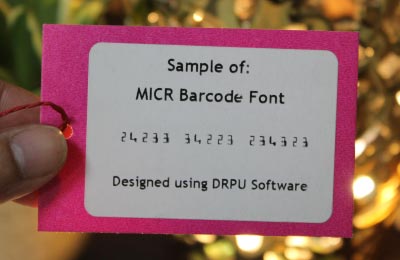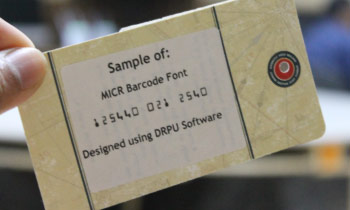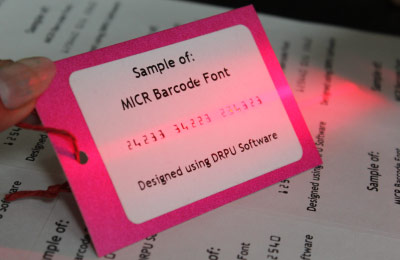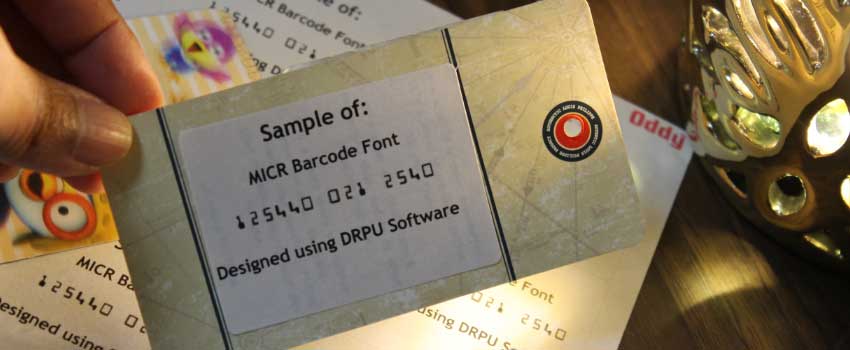Introduction of MICR Barcode

A MICR (Magnetic Ink Character Recognition) barcode is a type of barcode that uses magnetic ink to print characters that can be read by magnetic scanners. This barcode is commonly used in the banking industry for check processing and is also known as the "fractional routing number".
The MICR barcode is made up of four sets of numbers, each of which has a specific meaning. The first set is the Federal Reserve Routing Symbol, which identifies the specific Federal Reserve Bank or Branch where the check is to be processed. The second set is the Fractional Routing Number, which identifies the specific bank or credit union where the check was issued. The third set is the Check Serial Number, which is a unique identifier assigned to each check. The fourth set is the On-Us Number, which is a unique identifier assigned by the bank or credit union that issued the check.
The MICR barcode is printed on the bottom of a check, typically in the lower right-hand corner. The barcode is printed using magnetic ink, which allows it to be read by a magnetic scanner. The scanner reads the characters in the barcode and converts them into digital data, which can be used to process the check.
One of the advantages of using a MICR barcode is that it allows for faster and more accurate processing of checks. When a check is processed using a MICR scanner, the scanner can read the characters in the barcode much more quickly and accurately than a human could. This can help to reduce errors and improve efficiency in the check processing system.
Another advantage of using a MICR barcode is that it provides a standardized method for encoding check information. This can help to ensure that the information on the check is consistent and accurate, which can help to prevent fraud and other errors.
Overall, the MICR barcode is an important tool in the banking industry for processing checks. It provides a fast, accurate, and standardized method for encoding check information, which can help to improve efficiency and reduce errors in the check processing system.
Information Encoded in a MICR Barcode
A MICR barcode, also known as the code line or the short code line, is a subset of the Magnetic Ink Character Recognition (MICR) technology used in banking and financial institutions to encode and process information on checks and other financial documents. Unlike the traditional long code line, which contains a significant amount of information such as the bank routing number, account number, check number, and amount, the MICR barcode contains only a limited amount of data, including the check number and the transaction code.
The check number is a unique identifier assigned to each check, and the transaction code is used to indicate the type of transaction, such as a deposit, withdrawal, or transfer. The transaction code is a two-digit number that corresponds to a specific type of transaction, and it is used by the bank's computer systems to process the check and update the account balance accordingly.
In addition to the check number and transaction code, the MICR barcode may also include other information, such as the branch code or location code, which identifies the specific bank branch where the check was processed. This information is used by the bank's computer systems to route the check to the correct location for processing and clearance.
Overall, the MICR barcode is a streamlined version of the traditional long code line, designed to simplify and speed up the processing of checks and other financial documents while maintaining a high level of accuracy and security. By limiting the amount of information encoded in the barcode, the MICR code line reduces the amount of data that needs to be read and processed, resulting in faster and more efficient processing times.
Print MICR Barcode on a Check

A MICR barcode is printed on a check using a special ink and a specific font that meets the ANSI X9.27 standard. This font is called the E-13B font and is a special magnetic ink character recognition (MICR) font that is used for encoding the routing and account numbers of a check in a machine-readable format.
The E-13B font consists of 14 characters, which include ten numeric digits (0-9), a dash (-), and three special symbols called transit, on-us, and amount. These characters are printed using a special magnetic ink that contains iron oxide particles. When the check is processed through a machine reader, the magnetic ink characters are read by the machine, and the information encoded in the MICR barcode is extracted.
The MICR barcode is typically printed on the bottom of the check, in a location known as the MICR line. This line is located to the right of the check number and is divided into three sections: the routing number, the account number, and the check number. The MICR barcode is printed using a specific pattern of characters that corresponds to the routing and account numbers of the check.
The routing number is printed first and consists of nine digits. This number identifies the financial institution that issued the check and is used to route the check to the appropriate bank for processing. The account number is printed next and consists of up to 17 digits. This number identifies the specific account that the check is drawn from. Finally, the check number is printed last and consists of up to six digits. This number is used to identify the specific check within the account.
To ensure that the MICR barcode is readable by machine, it must be printed using the correct font, ink, and spacing. The ANSI X9.27 standard specifies the requirements for printing the MICR barcode and ensures that the information encoded in the barcode can be read accurately by machine readers.
Download and Install Barcode Software
Overall, the printing process for a MICR barcode on a check is a precise and standardized process that ensures the accuracy and efficiency of check processing.
Read MICR Barcode by Automated Check Processing Equipment

Automated check processing equipment, including check readers and sorters, use a technique called Magnetic Ink Character Recognition (MICR) to read the MICR barcode. This technique uses a magnetic field and a special ink containing iron oxide to recognize the characters printed on the check.
The MICR barcode consists of four separate fields of characters, each with a specific purpose. The first field is the routing number, which identifies the bank that issued the check. The second field is the account number, which identifies the specific account that the check is drawn from. The third field is the check number, which identifies the specific check being processed. The fourth and final field is the amount, which indicates the value of the check.
To read the MICR barcode, the check processing equipment uses a magnetic head to detect the magnetic ink characters as they pass through the machine. The magnetic head is positioned close to the surface of the check, and it generates a magnetic field that interacts with the iron oxide particles in the ink. This interaction creates an electrical signal that is transmitted to a computer or other processing unit.
The computer analyzes the electrical signals and compares them to a database of known characters. When a match is found, the corresponding character is identified and recorded. This process is repeated for each character in the MICR barcode until the entire code has been read.
Once the MICR barcode has been read, the processing equipment uses the information to sort and route the check to the appropriate bank or processing center. The routing number is used to determine the destination bank, while the account number and check number are used to identify the specific account and check being processed. The amount field is used to validate the value of the check and ensure that it matches the amount written in words on the check.
Overall, the MICR barcode provides a reliable and efficient way to process checks automatically. It minimizes the need for manual data entry and reduces the risk of errors, which can save time and improve accuracy in the check processing industry.
Standards for MICR Barcode
There are standards for MICR barcodes. These standards ensure that the information encoded in the barcode can be accurately and reliably read by automated check processing equipment.
The standard for MICR barcodes is maintained by the American Bankers Association (ABA). The ABA standard defines the font, character set, and size of the MICR line on the bottom of a check, including the MICR barcode. The standard also specifies the encoding rules for the MICR line, including the format of the routing number, account number, and check number.
The ABA standard requires that the MICR line be printed using a magnetic ink that can be read by magnetic scanners. The magnetic ink must meet specific criteria for readability, including magnetic strength and ink viscosity. The standard also specifies the position and orientation of the MICR line on the bottom of the check.

In addition to the ABA standard, there are also international standards for MICR barcodes. The International Organization for Standardization (ISO) has developed standards for the encoding and printing of MICR lines on financial documents, including checks. The ISO standard specifies the font, character set, and size of the MICR line, as well as the encoding rules for the routing number, account number, and check number.
Compliance with these standards is important for ensuring that MICR barcodes can be accurately and reliably read by automated check processing equipment. Non-compliance can result in errors or delays in the processing of checks, which can be costly for banks and their customers.